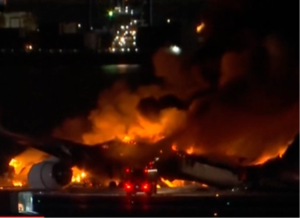
I woke up to pictures of flames roaring from a Japanese jet on the runway in Tokyo – a fireball that sent shivers down my spine. How many poor souls had been consumed by the fire?
Subconsciously, I recalled hundreds, perhaps thousands of times I have landed in an aeroplane. And I wondered.
Other than some modest buffeting, I have only had two close-run aviation experiences. The first was landing at Johannesburg airport in a jet that had called out a flotilla of fire trucks along the runway because the pilot was unable to lower the wheels. Flying was still quite novel to me at the time, and I happily filmed the event on my Standard 8 camera rather than consider what I would do when we touched down. In the end, at the last minute, the wheels deployed, and all was fine.
The other time was a tourist flight over the Grand Canyon from Las Vegas in a 7-passenger prop aircraft. Half-way out the pilot turned back, racing away from an incoming storm. Even though I was belted in, my head hit the roof of the plane with the buffeting and the back of the pilot’s seat broke off, leaving him effectively sitting on a stool as he flew us back. Safely. On stepping off the plane, he knelt and kissed the ground in relief.
Yet, amazingly, while so sadly 5 of the crew on the Japan coast guard ‘plane struck by this jet on landing were killed, all 379 passengers and crew of the Japan Airlines flight made it off safely.
Investigations are ongoing as to what happened, but experts are already saying that the successful evacuation is down to the implementation of safety standards honed over time and the safety culture embedded in Japan Airlines’ staff. Within a few seconds of the plane coming to a stop, chutes had been run out and passengers efficiently ushered out of the smoke-filled cabin.
In business, I have read and learned about Japanese techniques and particularly Kaizen (continuous improvement). It was probably this philosophy that saved the lives of so many.
Apparently, it was the deadliest single-aircraft accident in aviation history nearly 40 years ago that spurred the airline to where it is today. In August 1985, 520 people died on a JAL flight after a faulty repair by Boeing technicians. JAL wanted to ensure that nothing like this could happen again, and they set to work learning from mistakes – understanding that all problems present opportunities to improve.
That crash imbued a strict culture about applying standard operating procedures that emphasises almost intuitive, rapid crew reactions that can and did save hundreds of lives. As the pilot commented, such procedures are written in the blood of those who had not been as fortunate.
Additionally, there has been a continuous improvement in safety features learned from past experience; space around the exits, floor exit lights, ensuring that the person occupying the overwing exit is able to open it, clearer exit signs, fire retardant materials.
I take away two things from this event:
- Choose your airline carefully (e.g. I would never fly Aeroflot, especially given the degrading maintenance capability with western sanctions).
- When life presents you with a problem, a disaster even, don’t let it dishearten you, it is an opportunity to learn and do better next time.
Happy New Year!